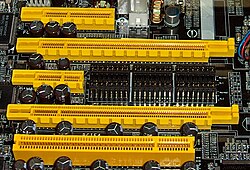PCI express
PCI Express (abbreviated PCIe or PCI-e) is a serial, point-to-point or "dedicated" data communication bus (set of signal conductors), improvement of the previous parallel and shared bus, the PCI bus. This system is mainly supported by Intel, which began developing the standard under the project name Arapahoe after withdrawing from the Infiniband system.
PCI Express is abbreviated as PCI-E or PCIe, although it is often mistakenly abbreviated as PCI-X or PCIx. However, PCI Express has nothing to do with PCI-X OG, which is an evolution of PCI, in which the bandwidth is increased by increasing the frequency, becoming 32 times faster than PCI 2.1. since, although its speed is higher than PCI Express, it has the drawback that when installing more than one device, the base frequency is reduced and transmission speed is lost.
Structure
This bus is structured as point-to-point rails, full-duplex, working in series. In PCIe 1.1 (the most common in 2007) each lane carries 250 MB/s in each direction. PCIe 2.0 doubles this rate to 500 MB/s and PCIe 3.0 doubles it again (1 GB/s per lane).
Each expansion slot carries one, two, four, eight, or sixteen lanes of data between the motherboard and attached cards. The number of lanes is written with a prefix x (x1 for a single lane and x16 for a card with sixteen lanes); 500MB/s x16 gives a maximum bandwidth of 8 GB/s in each direction for PCIE 2.x. In the most common use of x16 for PCIE 1.1 it provides a bandwidth of 4 GB/s (250 MB/s x 16) in each direction. Compared to other buses, a single lane is about twice as fast as normal PCI; a four lane slot has bandwidth comparable to the fastest version of PCI-X 1.0, and eight lanes has bandwidth comparable to the fastest version of AGP.
A PCi Express 3.0 slot has 1 GB/s directional and 2 GB/s bi-directional, so for x16 they achieve a theoretical maximum of 16 GB/s directional and 32 GB/s bi-directional
Uses
PCI Express is intended to be used only as a local bus, although there are extenders capable of connecting multiple motherboards using copper cables or even fiber optics. Because it is based on the PCI bus, current cards can be converted to PCI Express by changing only the physical layer. The superior speed of PCI Express will allow it to replace almost all other buses, AGP and PCI included. Intel's idea is to have a single PCI Express controller communicating with all devices, rather than the current northbridge/southbridge system.
PCI Express is not yet fast enough to be used as a memory bus. This is a disadvantage that the similar HyperTransport system does not have, which can also have this use. Furthermore, it does not offer the flexibility of the InfiniBand system, which has similar performance, and can also be used as an external internal bus.
This connector is mostly used to connect graphics cards. PCI Express in 2006 is perceived as a standard for PC motherboards, especially graphics cards. Brands like Advanced Micro Devices and nVIDIA among others have PCI Express graphics cards.
It is also being used on multiple occasions as a hub for high-performance solid-state drive transfers, with rates in excess of Gigabyte per second.
Speeds
| Version of PCI Express | Online code | Transfer speed | Bandwidth | ||||
|---|---|---|---|---|---|---|---|
| By lane | In x1 | In x4 | In x8 | In x16 | |||
| 1.0 | 8b/10b | 2.5 GT/s | 2 Gbit/s (250 MB/s) | 250 MB/s | 1 GB/s | 2 GB/s | 32 Gbit/s (4 GB/s) |
| 2.0 | 8b/10b | 5 GT/s | 4 Gbit/s (500 MB/s) | 500 MB/s | 2 GB/s | 4 GB/s | 64 Gbit/s (8 GB/s) |
| 3.0 | 128b/130b | 8 GT/s | 7.9 Gbit/s (984.6 MB/s) | 985 MB/s | 3.9 GB/s | 7.8 GB/s | 126 Gbit/s (15.8 GB/s) |
| 4.0 | 128b/130b | 16 GT/s | 15.8 Gbit/s (1969.2 MB/s) | 1.9 GB/s | 7.8 GB/s | 15.8 GB/s | 252,1 Gbit/s (31.5 GB/s) |
| 5.0 | 128b/130b | 32 GT/s | 31.6 Gbit/s (3938.4 MB/s) | 3.9 GB/s | 15.8 GB/s | 31.5 GB/s | 504 Gbit/s (63 GB/s) |
| 6.0 | 242b/256b | 64 GT/s | 64 Gbit/s (7877 MB/s) | 7.5 GB/s | 30.2 GB/s | 60.5 GB/s | 1008 Gbit/s (126 GB/s) |
Form factors
- Low-height card
- Mini Card: Mini PCI format replacement (with PCIe x1, USB 2.0 and SMBus buses on connector)
- ExpressCard: successor to PC card format (with PCIe x1 and USB 2.0; hot connectable)
- XMC: similar to CMC/PMC (with PCIe x4 or Serial RapidI/O)
- AdvancedTCA: a CompactPCI and PXI complement for technology applications; supports backplane topologies based on serial communication
- AMC: an AdvancedTCA specification complement; supports processors and input/output modules on ATCA plates (PCIe x1,x2,x4 or x8).
- PCI Express External Cabling
- Mobile PCI Express Module (MXM) A specification of portable graphic modules created by NVIDIA.
- Advanced Express I/O Module (AXIOM) graphic module design created by ATI Technologies.
Contenido relacionado
PHP nuke
DirectX
EPROM memory
Windows 98
Turbo Pascal

